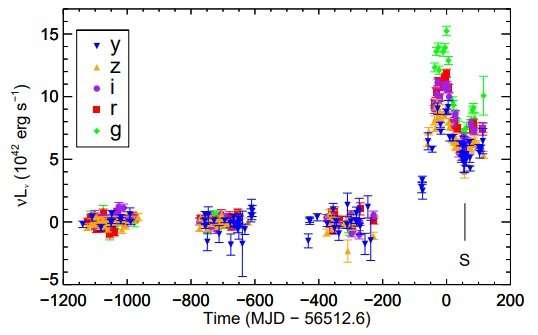November 19, 2018 report
Rapid 'turn-on' of a nuclear transient observed by astronomers

An international team of astronomers has observed the peculiar activity of a nuclear transient event known as PS1-13cbe. The transient, which occurred in the nucleus of the galaxy SDSS J222153.87+003054.2, experienced a rapid flare-up lasting about 70 days. The finding is reported in a paper published November 8 on arXiv.org.
At a redshift of 0.12355, SDSS J222153.87+003054.2 (or SDSS J2221+0030 for short) is a type 2 Seyfert galaxy. It has a central supermassive black hole (SMBH) with an estimated mass of around 20 million solar masses.
In general, Seyfert galaxies host active galactic nuclei (AGN) that produce spectra line emissions from highly ionized gas. Astronomers classify these galaxies as type 1 or 2, depending on the emission lines shown by their spectra.
However, observations show that various AGN types are observed in the same object at different epochs of time. One explanation of this phenomenon is that some type 2 Seyfert galaxies are actually type 1 with inactive engines. This suggests that type 2 Seyfert galaxies are an evolved version of the type 1.
Some AGNs showcase X-ray absorption variations, and are thus called "changing-look" AGNs. Furthermore, in some Seyfert galaxies, the broad emission lines disappear and, while in others broad emission lines appear, what astronomers describe as a "turn-on" of an AGN. So far, the most rapid "turn-ons" observed last less than one year.
Now, a team of researchers led by Reza Katebi of Ohio University reports a rapid "turn-on" of the nuclear transient PS1-13cbe in the nucleus of the galaxy SDSS J2221+0030. PS1-13cbe was detected on July 9, 2013 in the Pan-STARRS1 (PS1) sky survey. Additional observations of this transient and its host galaxy, that led to the new findings, were conducted by the team using NASA's Swift spacecraft, the 6.5 m Magellan Clay telescope and the 2.4 m Hiltner telescope.
According to the paper, PS1-13cbe brightened in the course of about 70 days and reached a peak total optical luminosity of approximately 10.6 tredecillion erg/s, while its temperature roughly stayed constant. Moreover, this rapid "turn-on" of PS1-13cbe was accompanied by the appearance of broad Balmer lines and hence a transition to a type 1 Seyfert galaxy.
"At the time of the outburst, the galaxy changed type to a Seyfert 1 as broad Hα and Hβ appeared and the continuum brightened in the spectrum taken with LDSS3 +57 days after the peak and then changed its type back to a Seyfert 2 as the broad Hα and Hβ disappeared in the spectrum taken with OSMOS 2 years later and did not reappear in spectra taken three and four years after the outburst," the researchers wrote in the paper.
The observations allowed Katebi's team to conclude that PS1-13cbe is a "changing-look" AGN that has been powered by instabilities in the accretion disk. They added that the "turn-on" of this AGN is among the shortest observed in a "changing look" active galactic nuclei.
More information: Reza Katebi et al. PS1-13cbe: The Rapid "Turn on" of a Seyfert 1. arXiv:1811.03694 [astro-ph.GA]. arxiv.org/abs/1811.03694
© 2018 Science X Network





















